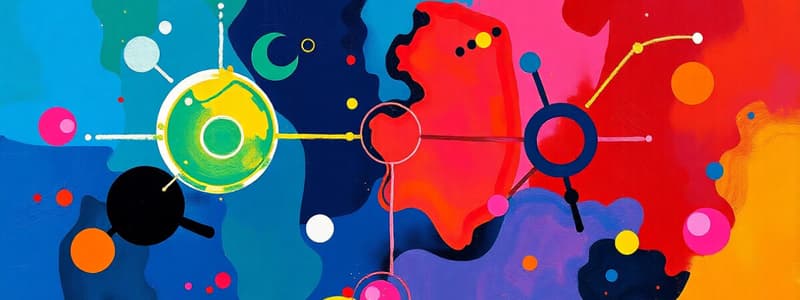Podcast
Questions and Answers
Which of the following best describes a reaction mechanism?
Which of the following best describes a reaction mechanism?
- The overall balanced equation representing the chemical change.
- The energy required for a reaction to occur.
- The step-by-step sequence of reactions by which the overall chemical change occurs. (correct)
- The rate at which reactants are converted into products.
In a proposed reaction mechanism, what term describes a species that appears in one step but is consumed in a later step, and therefore does not appear in the overall balanced equation?
In a proposed reaction mechanism, what term describes a species that appears in one step but is consumed in a later step, and therefore does not appear in the overall balanced equation?
- Intermediate (correct)
- Reactant
- Catalyst
- Product
In the context of chemical reactions, what does the collision theory primarily explain?
In the context of chemical reactions, what does the collision theory primarily explain?
- The equilibrium constants of reversible reactions.
- The spontaneity of thermodynamically favored reactions.
- The conservation of mass in chemical reactions.
- How particle collisions lead to chemical reactions (correct)
According to collision theory, what are the two primary factors that determine whether a collision between reactant molecules will lead to a successful reaction?
According to collision theory, what are the two primary factors that determine whether a collision between reactant molecules will lead to a successful reaction?
What is the role of activation energy in a chemical reaction?
What is the role of activation energy in a chemical reaction?
Which statement is true regarding the relationship between bond breaking and bond forming in a chemical reaction?
Which statement is true regarding the relationship between bond breaking and bond forming in a chemical reaction?
What is the significance of an 'activated complex' in a chemical reaction?
What is the significance of an 'activated complex' in a chemical reaction?
How does increasing the temperature generally affect the rate of a chemical reaction, according to the principles discussed?
How does increasing the temperature generally affect the rate of a chemical reaction, according to the principles discussed?
Which of the following is a key factor in determining the speed of a chemical reaction?
Which of the following is a key factor in determining the speed of a chemical reaction?
Consider the elementary steps of a reaction mechanism. What is the classification of a reaction where all reactants and products exist in the same phase?
Consider the elementary steps of a reaction mechanism. What is the classification of a reaction where all reactants and products exist in the same phase?
A chemist proposes a multi-step reaction mechanism. What type of experimental evidence would be most useful in determining the probable sequence of these steps?
A chemist proposes a multi-step reaction mechanism. What type of experimental evidence would be most useful in determining the probable sequence of these steps?
For the elementary reaction $A + B \rightarrow C$, which of the following molecular orientations would likely be most effective in leading to product formation, assuming A and B react through specific sites?
For the elementary reaction $A + B \rightarrow C$, which of the following molecular orientations would likely be most effective in leading to product formation, assuming A and B react through specific sites?
The reaction $2H_2(g) + O_2(g) \rightarrow 2H_2O(l)$ is exothermic, yet it does not occur spontaneously at room temperature. Why?
The reaction $2H_2(g) + O_2(g) \rightarrow 2H_2O(l)$ is exothermic, yet it does not occur spontaneously at room temperature. Why?
In an energy diagram for a chemical reaction, what does the 'activation energy' correspond to?
In an energy diagram for a chemical reaction, what does the 'activation energy' correspond to?
Consider a reaction coordinate diagram. What does a higher activation energy for a reaction indicate about the reaction rate?
Consider a reaction coordinate diagram. What does a higher activation energy for a reaction indicate about the reaction rate?
What happens to the kinetic energies of molecules as temperature increases, according to kinetic-molecular theory?
What happens to the kinetic energies of molecules as temperature increases, according to kinetic-molecular theory?
Consider a reaction with an activation energy ($E_a$) of 50 kJ/mol. If the energy of the reactants is 20 kJ/mol, and the energy of the products is -10 kJ/mol, what is the energy of the activated complex?
Consider a reaction with an activation energy ($E_a$) of 50 kJ/mol. If the energy of the reactants is 20 kJ/mol, and the energy of the products is -10 kJ/mol, what is the energy of the activated complex?
For a reversible reaction, what is the relationship between the activation energy for the forward reaction ($E_{a,forward}$) and the activation energy for the reverse reaction ($E_{a,reverse}$) in an exothermic reaction?
For a reversible reaction, what is the relationship between the activation energy for the forward reaction ($E_{a,forward}$) and the activation energy for the reverse reaction ($E_{a,reverse}$) in an exothermic reaction?
Given the reaction $I_2(g) \rightleftharpoons 2I(g)$, which represents the first step of a possible reaction mechanism for the formation of HI. If the forward reaction is endothermic, how would you describe the change in enthalpy?
Given the reaction $I_2(g) \rightleftharpoons 2I(g)$, which represents the first step of a possible reaction mechanism for the formation of HI. If the forward reaction is endothermic, how would you describe the change in enthalpy?
In a reaction coordinate diagram, the difference in energy between the reactants and the products is known as what?
In a reaction coordinate diagram, the difference in energy between the reactants and the products is known as what?
How does the addition of a catalyst affect the activation energy of a reaction?
How does the addition of a catalyst affect the activation energy of a reaction?
What is the primary reason why only a fraction of collisions between reactant molecules lead to a chemical reaction, even when they have sufficient energy?
What is the primary reason why only a fraction of collisions between reactant molecules lead to a chemical reaction, even when they have sufficient energy?
Which of the following statements accurately reflects bond energies in relation to the stability of molecules?
Which of the following statements accurately reflects bond energies in relation to the stability of molecules?
If a reaction mechanism involves multiple steps, what is the rate-determining step?
If a reaction mechanism involves multiple steps, what is the rate-determining step?
How can the enthalpy of a reaction ($\Delta H$) be determined from the activation energies of the forward ($E_{a,forward}$) and reverse ($E_{a,reverse}$) reactions?
How can the enthalpy of a reaction ($\Delta H$) be determined from the activation energies of the forward ($E_{a,forward}$) and reverse ($E_{a,reverse}$) reactions?
Flashcards
What is a reaction mechanism?
What is a reaction mechanism?
The step-by-step sequence of reactions by which the overall chemical change occurs.
What are reaction intermediates?
What are reaction intermediates?
Species that appear transiently in some steps of a reaction mechanism but are not in the net equation.
What is a homogeneous reaction?
What is a homogeneous reaction?
A reaction where all reactants and products exist in a single phase.
What is the collision theory?
What is the collision theory?
Signup and view all the flashcards
How do molecules react?
How do molecules react?
Signup and view all the flashcards
When do collisions fail? (Collision theory)
When do collisions fail? (Collision theory)
Signup and view all the flashcards
What is activation energy (Ea)?
What is activation energy (Ea)?
Signup and view all the flashcards
What is an activated complex?
What is an activated complex?
Signup and view all the flashcards
How does temperature affect reaction rate?
How does temperature affect reaction rate?
Signup and view all the flashcards
What is ΔEforward?
What is ΔEforward?
Signup and view all the flashcards
What is ΔEreverse?
What is ΔEreverse?
Signup and view all the flashcards
What is Ea?
What is Ea?
Signup and view all the flashcards
What is E'a?
What is E'a?
Signup and view all the flashcards
Study Notes
Reaction Process Overview
- Chemical reactions occur at varying speeds
- Reaction speed hinges on the energy pathway and molecular-level changes during substance interaction
- Objectives include explaining reaction mechanisms, using collision theory, defining the activated complex and relating activation energy to enthalpy
Reaction Mechanisms
- High kinetic energy enables ions/molecules to overcome repulsive forces and react
- Chemical equations depict reactions but not their mechanisms
- Reaction mechanism refers to the step-by-step sequence of reactions causing a chemical change
- A reaction appearing simple may involve multiple steps
- Experiments determine the probable sequence in a reaction mechanism
- Intermediates are species appearing in some steps but not in the net equation
- Homogeneous reactions involve reactants/products existing in a single phase
Reaction mechanisms for HI formation
- Possible reaction mechanisms for the formation of HI are:
- I2 -> 2I
- 2I + H2 -> 2HI or
- I2 -> 2I
- I + H2 -> H2I
- H2I + I -> 2HI
- Reaction intermediates like I and H2I do not appear in the net equation
Collision Theory
- Reactions occur when particles collide
- Collision theory encompasses assumptions about collisions and reactions
- Effective collisions require favorable orientation and sufficient energy to merge valence electrons and disrupt bonds
Collision Theory Factors
- Chemical reactions form new bonds between specific atoms in colliding molecules
- Molecules do not react unless correct atoms are close and properly oriented
- Collision theory identifies two reasons collisions between reactant molecules might not yield a new chemical species
- Insufficient energy during collision
- Improper orientation of colliding molecules
Activation Energy
- Forming water from oxygen and hydrogen is exothermic: 2H2(g) + O2(g) -> 2H2O(l)
- Reactions do not always occur spontaneously even at room temperature
- Bond breaking is endothermic, while bond formation is exothermic
- Initial energy overcomes repulsion between reactant molecules
- Activation energy (Ea) is the minimum energy needed to transform reactants into an activated complex
Activated Complex
- In the brief period of bond breakage and formation, the collision complex is in a transition state with partial bonding
- An activated complex is a transitional structure from effective collision, where old bonds break and new ones form
- The activated complex has a very short life
Activated Complex and Reaction Rate
- The kinetic-molecular theory postulates that higher temperatures increase molecular speeds and kinetic energies
- Collisions must have enough energy to form an activated complex for a reaction to occur
- Raising reaction temperature increases molecules with necessary activation energy, accelerating the reaction rate
Sample Problem A Solution
- ΔEforward = energy of products – energy of reactants
- ΔEforward = 50 kJ/mol – 0 kJ/mol = +50 kJ/mol
- ΔEreverse = energy of reactants – energy of products
- ΔEreverse = 0 kJ/mol - 50 kJ/mol = - 50 kJ/mol
- Ea = energy of activated complex – energy of reactants
- Ea = 80 kJ/mol – 0 kJ/mol = 80 kJ/mol
- E'a = energy of activated complex – energy of products
- E'a = 80 kJ/mol - 50 kJ/mol = 30 kJ/mol
Studying That Suits You
Use AI to generate personalized quizzes and flashcards to suit your learning preferences.




